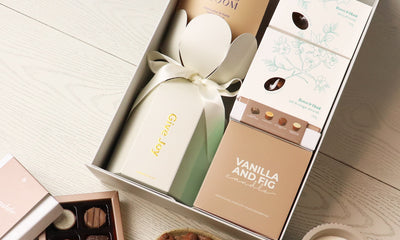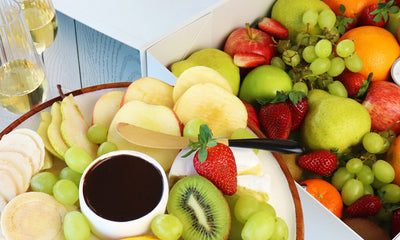What exactly is high tea?
High tea is a British tradition that involves a light meal of assorted finger sandwiches, scones with clotted cream and jam, cakes, and pastries, served with a pot of tea. It's different from "afternoon tea," which is a more formal affair with finer delicacies and served later in the day. High Tea is often served at a table with high-back chairs whilst sipping tea from fine bone china and enjoying conversation with friends and family. Baby showers, bridal showers, kitchen teas and special occasions are typically celebrated with a high tea.
What is the proper etiquette for high tea?
The most polite thing to remember when hosting or attending a high tea is to serve others before yourself and to avoid reaching across the table.
However, if you want to get into the more nitty-gritty details of high tea etiquette, you may want to consider the following tips.
- It’s customary for the person doing the hosting to pour the tea out, and for the teapot to be left on the table with the spout facing the person who poured.
- When stirring your tea, avoid clinking the spoon against the sides of the cup - in fact, the correct way to stir is from the midnight position of the cup back and forth to the 6 o'clock position.
- Place your spoon beside your cup on the saucer, as opposed to leaving it in your teacup.
What do ladies wear to high tea?
There are varying levels of formality depending on the type of tea party you are attending. You can generally expect summer or spring dresses, longer flowing gowns or more formal vintage gowns, and two-piece skirt and blouse or pant and blouse sets to be appropriate.
Think Zimmerman, AJE, Alemais, or simple linen dresses from Aere.
Are there any dress code expectations for high tea?
"Smart casual" is the best way to describe the vibe. Think sundresses, skirts with blouses, or dress pants with a nice top. Men can opt for collared shirts, chinos, or dressy slacks with a sweater. It's best to avoid overly casual attire like ripped jeans, t-shirts, or activewear. The goal is to strike a balance between feeling comfortable and put together for a special occasion.
Can dietary restrictions be accommodated during high tea?
Absolutely! High tea can be enjoyed by everyone, regardless of dietary restrictions. Here's how:
- Communicate in advance: Many high tea establishments offer alternative menus or will work with you to create options that fit your needs or host your own at home knowing you control the menu. A simple solution is to part make and part get delivered.
- Expect adaptations: The traditional high tea menu might need some adjustments. Those with gluten sensitivities might be offered gluten-free scones or sandwiches on alternative breads.
- Dairy-free and vegan options: These are becoming increasingly common. High tea spots might have dairy-free spreads and plant-based scones or cakes. If unsure, always ask about the ingredients
- Be open to new things: High tea is a chance to explore new flavours! Just like our Gourmet High Tea
By planning ahead and communicating effectively, you can ensure a delightful high tea experience that caters to everyone's needs.
Is it easy to host high tea at home?
Hosting a high tea at home can be as easy. While traditional high tea involves a specific menu and elegant tableware, you can create a delightful experience with simpler options. The key elements are a selection of savoury finger foods, scones with jam and cream, sweet treats, and of course, a variety of teas. You can use what you have on hand for serving ware, or borrow from friends. With a little planning and creativity, you can enjoy a relaxing and delicious high tea in the comfort of your own home.
What are some popular tea options for high tea?
Two very common teas that are often enjoyed at high tea are Early Grey and English Breakfast teas that complement delicious treats served at these events. Herbal and organic teas are popular options to have at high teas. Our friends at Tea Tonic stock a variety of organic teas that not only taste delicious but are the highest quality, pure ingredients and promote good health. They are always adding new teas every year, each as flavoursome as the last – and all made in Australia from the finest organic ingredients. Their website offers brewing guides and information on the health benefits of different tea types, allowing you to tailor your high tea menu to promote well-being alongside enjoyment. With the right tea, you can transform your high tea into a delightful ritual that nourishes both body and soul.
What is the difference between high tea and afternoon tea?
The main differences between high tea and afternoon tea is the menu and social etiquette.
Origins and Timing:
Afternoon tea: Originating in England in the 1840s, afternoon tea was introduced as a light meal to bridge the long gap between lunch and dinner, typically served between 3:00 pm and 5:00 pm.
High tea: High tea originated among the working class in Britain during the 18th and 19th centuries. It was a more substantial meal served around 5:00 pm to 7:00 pm, after a day of manual labor, distinguishing it from the more aristocratic afternoon tea.
Menu:
Afternoon tea: Typically consists of dainty sandwiches with crusts removed, scones served with clotted cream and jam, and a selection of cakes or pastries. The emphasis is on light, sweet, and delicate treats.
High tea: Offers heartier fare, including savory dishes such as pies, quiches, meats, and cheeses, alongside cakes, scones, and tea. The spread is more substantial, resembling a light dinner rather than a light snack.
How did high tea become more popular than afternoon tea?
Simplicity and Accessibility: High tea typically involves simpler, more substantial dishes compared to the delicate and refined offerings of afternoon tea. This simplicity made it more accessible and appealing to a wider audience, including those who were not part of the aristocracy or upper classes.
In summary, while both afternoon tea and high tea involve the consumption of tea and light meals, their timing, menu, and social contexts differentiate them significantly. Afternoon tea is a refined and leisurely affair with delicate treats, whereas high tea is a more substantial and hearty meal associated with the working class.
High tea is a shared experience, immersing yourself in food finery and in current days, quite often celebration.
































